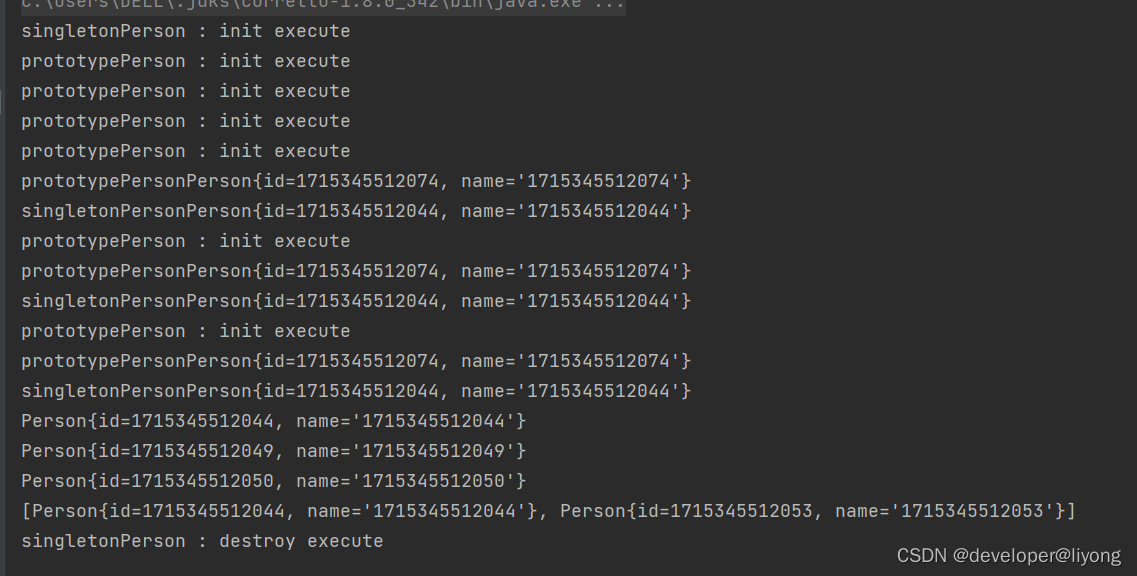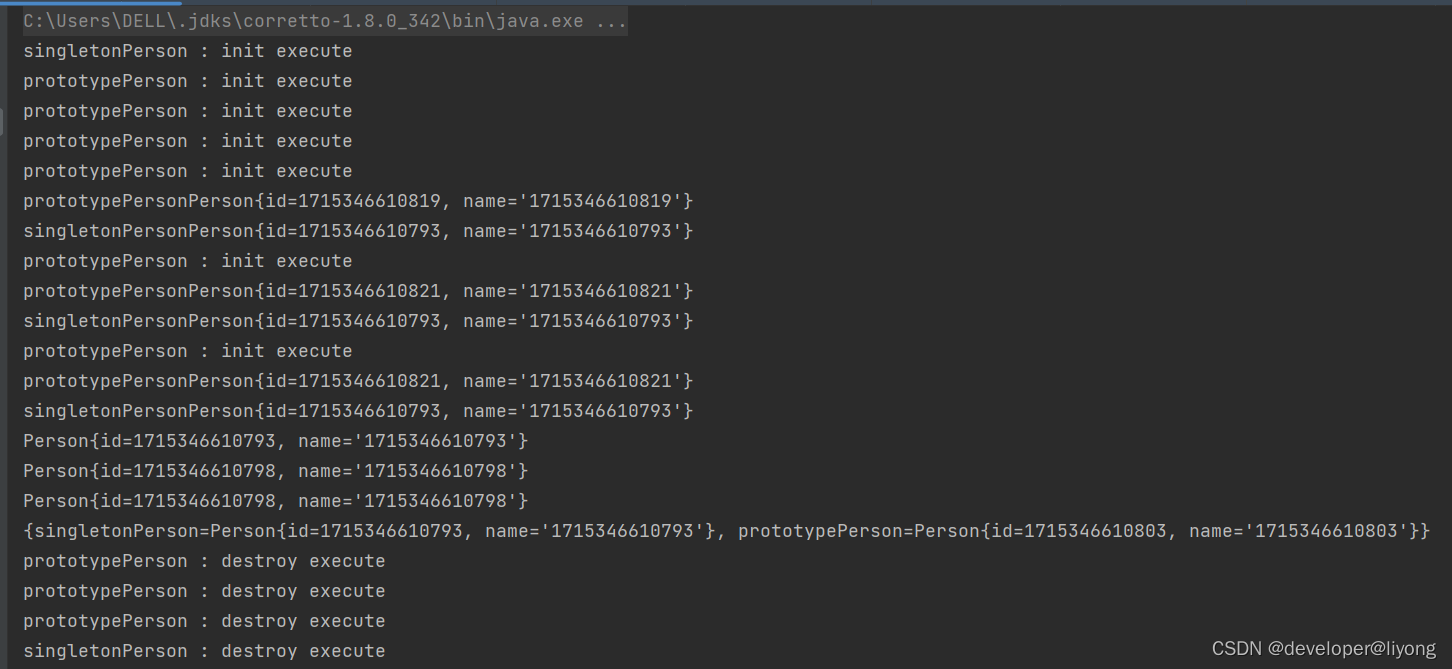作用域

作用域案例
public class BeanScopeDemo {@Autowired@Qualifier("singletonPerson")Person person;@Autowired@Qualifier("prototypePerson")Person person1;@Autowired@Qualifier("prototypePerson")Person person2;@AutowiredSet<Person> personSet;/*** 创建bean* @return*/public static Person createPerson(){Person person = new Person();person.setId(System.currentTimeMillis());person.setName(System.currentTimeMillis()+"");return person;}/*** 查找* @param context*/public static void scopeBeanLookUp(AnnotationConfigApplicationContext context){for (int i = 0; i < 3; i++) {Person prototypePerson = context.getBean("prototypePerson", Person.class);System.out.println("prototypePerson" + prototypePerson);Person singletonPerson = context.getBean("singletonPerson", Person.class);System.out.println("singletonPerson" + singletonPerson);}}private static void scopedBeansByInjection(AnnotationConfigApplicationContext context) {BeanScopeDemo bean = context.getBean(BeanScopeDemo.class);System.out.println(bean.person);System.out.println(bean.person1);System.out.println(bean.person2);System.out.println(bean.personSet);}public static void main(String[] args) {AnnotationConfigApplicationContext context = new AnnotationConfigApplicationContext();context.register(BeanScopeDemo.class);context.refresh();scopeBeanLookUp(context);scopedBeansByInjection(context);context.close();}/*** 默认scope 就是singleton* @return*/@Beanpublic static Person singletonPerson(){return createPerson();}@Bean@Scope(ConfigurableBeanFactory.SCOPE_PROTOTYPE)public static Person prototypePerson(){return createPerson();}
}
运行结果:

结论:
1 singleton Bean 无论依赖查找还是依赖注入,均为同一个对象
2 prototype Bean 无论依赖查找还是依赖注入,均为新生成的对象
3 如果为集合类型,则单例和原型对象各一个
单例模式和原型模式生命周期的不同
public class Person implements BeanNameAware {private Long id;private String name;/*** 不需要序列化*/private transient String beanName;@Overridepublic String toString() {return "Person{" +"id=" + id +", name='" + name + '\'' +'}';}public Long getId() {return id;}public void setId(Long id) {this.id = id;}public String getName() {return name;}public void setName(String name) {this.name = name;}@PostConstructpublic void init() {System.out.println(this.beanName + " : init execute");}@PreDestroypublic void destroy() {System.out.println(this.beanName + " : destroy execute");}@Overridepublic void setBeanName(String name) {this.beanName = name;}
}
改造Person以后我们继续调用上面的方法:

我们可以得到下面的结论:
1 原型和单例模式都是会执行postconstruct
2 原型模式的生命周期不能被spring完全管理,不会执行销毁方法
如果我们需要销毁,采用下面这种方式来操作
public class BeanScopeDemo implements DisposableBean {@Autowired@Qualifier("singletonPerson")Person person;@Autowired@Qualifier("prototypePerson")Person person1;@Autowired@Qualifier("prototypePerson")Person person2;@AutowiredMap<String, Person> personMap;@AutowiredConfigurableListableBeanFactory beanFactory;/*** 创建bean** @return*/public static Person createPerson() {Person person = new Person();person.setId(System.currentTimeMillis());person.setName(System.currentTimeMillis() + "");return person;}/*** 查找** @param context*/public static void scopeBeanLookUp(AnnotationConfigApplicationContext context) {for (int i = 0; i < 3; i++) {Person prototypePerson = context.getBean("prototypePerson", Person.class);System.out.println("prototypePerson" + prototypePerson);Person singletonPerson = context.getBean("singletonPerson", Person.class);System.out.println("singletonPerson" + singletonPerson);}}private static void scopedBeansByInjection(AnnotationConfigApplicationContext context) {BeanScopeDemo bean = context.getBean(BeanScopeDemo.class);System.out.println(bean.person);System.out.println(bean.person1);System.out.println(bean.person2);System.out.println(bean.personMap);}public static void main(String[] args) {AnnotationConfigApplicationContext context = new AnnotationConfigApplicationContext();context.register(BeanScopeDemo.class);context.refresh();scopeBeanLookUp(context);scopedBeansByInjection(context);context.close();}/*** 默认scope 就是singleton** @return*/@Beanpublic static Person singletonPerson() {return createPerson();}@Bean@Scope(ConfigurableBeanFactory.SCOPE_PROTOTYPE)public static Person prototypePerson() {return createPerson();}@AutowiredConfigurableListableBeanFactory beanFactory;@Overridepublic void destroy() throws Exception {this.person1.destroy();this.person2.destroy();for (Map.Entry<String, Person> entry : this.personMap.entrySet()) {String key = entry.getKey();BeanDefinition bd = beanFactory.getBeanDefinition(key);if (bd.isPrototype()) {entry.getValue().destroy();}}}
}运行结果:

可以看到原型模式的对象也被销毁了。
自定义Scope
1 首先自定义Scope
public class ThreadLocalScope implements Scope {public static final String SCOPE_NAME = "thread_local";private NamedThreadLocal<Map<String, Object>> threadLocal = new NamedThreadLocal<Map<String, Object>>("thread-local-scope") {public Map<String, Object> initialValue() {return new HashMap<>();}};private Map<String, Object> getContext() {return threadLocal.get();}@Overridepublic Object get(String name, ObjectFactory<?> objectFactory) {Map<String, Object> context = getContext();Object object = context.get(name);if (object == null) {object = objectFactory.getObject();context.put(name, object);}return object;}@Overridepublic Object remove(String name) {return getContext().remove(name);}@Overridepublic void registerDestructionCallback(String name, Runnable callback) {remove(name);}@Overridepublic Object resolveContextualObject(String key) {return getContext().get(key);}@Overridepublic String getConversationId() {return Thread.currentThread().getName();}
}2 查找方式
public class ThreadLocalScopeDemo {/*** 默认scope 就是singleton** @return*/@Bean@Scope(ThreadLocalScope.SCOPE_NAME)public static Person singletonPerson() {return createPerson();}/*** 创建bean** @return*/public static Person createPerson() {Person person = new Person();person.setId(System.currentTimeMillis());person.setName(System.currentTimeMillis() + "");return person;}public static void main(String[] args) {AnnotationConfigApplicationContext context = new AnnotationConfigApplicationContext();context.register(ThreadLocalScopeDemo.class);// 注册工厂 也就是 ThreadLocalScope.SCOPE_NAME 这个注入会走这里context.addBeanFactoryPostProcessor(beanFactory -> {beanFactory.registerScope(ThreadLocalScope.SCOPE_NAME, new ThreadLocalScope());});context.refresh();scopeBeansLookUp(context);context.close();}private static void scopeBeansLookUp(ApplicationContext context) {// 这里开启三个现场去查找for (int i = 0; i < 3; i ++) {Thread thread = new Thread(() -> {Person person = context.getBean( Person.class);System.out.println(Thread.currentThread().getId()+ " : " + person);});thread.start();try {thread.join();} catch (InterruptedException e) {throw new RuntimeException(e);}}}
}
结果:

也就几说我们可以减少对象的创建因为我们在Threadlocal里面存储了,所以线程内部是可以复用的,不存在线程安全问题。
比如SimpleDateFormat是非线程安全的,所以可以采用这种方式来实现。
拓展提示:SpingCloud中的@RefreshScope
参考资料:小马哥核心编程思想















![P8803 [蓝桥杯 2022 国 B] 费用报销](http://pic.xiahunao.cn/P8803 [蓝桥杯 2022 国 B] 费用报销)

)

